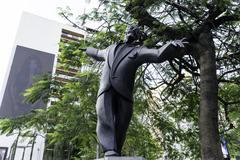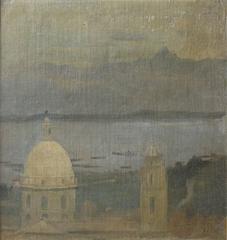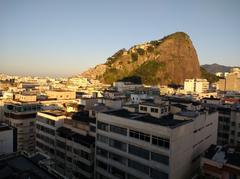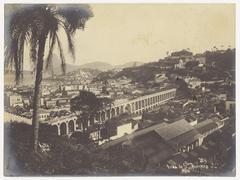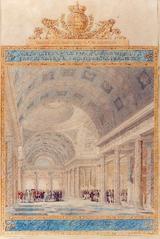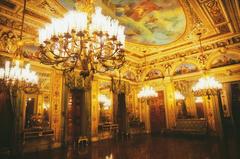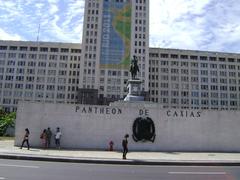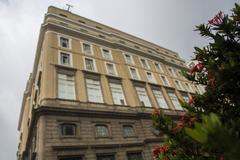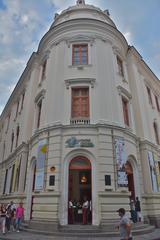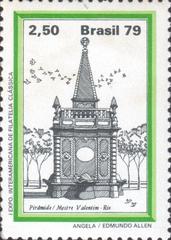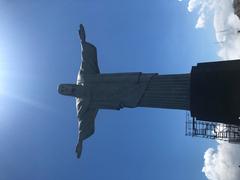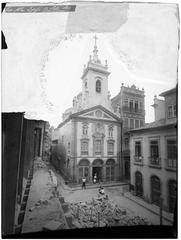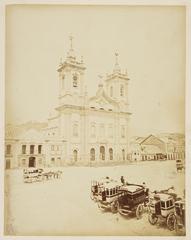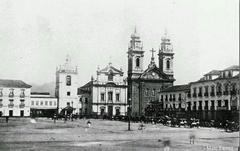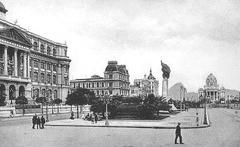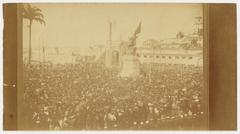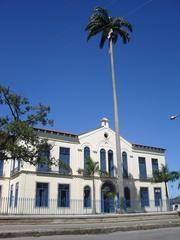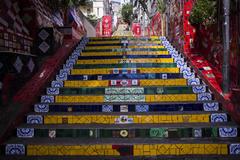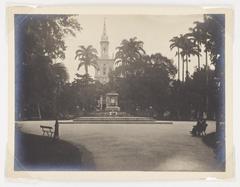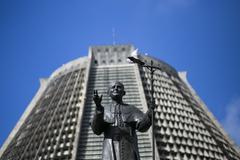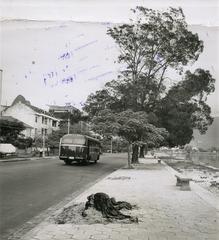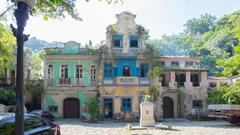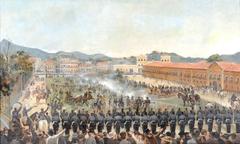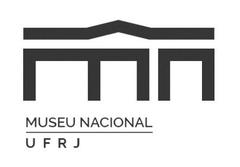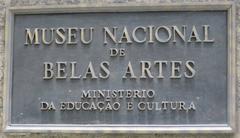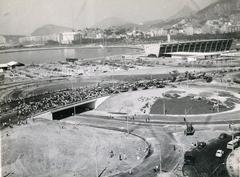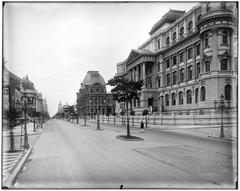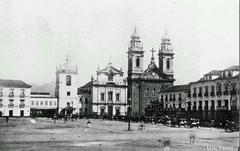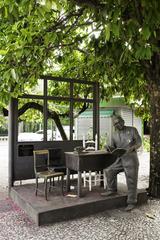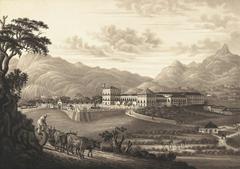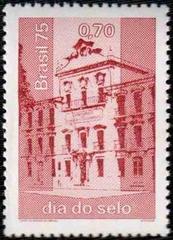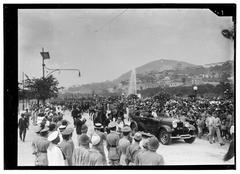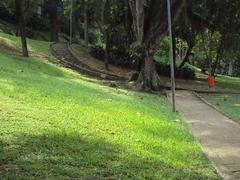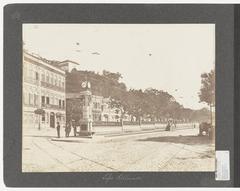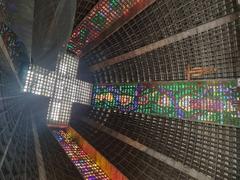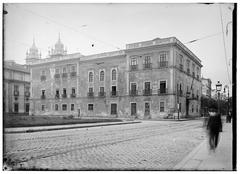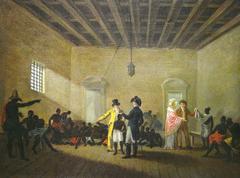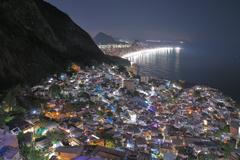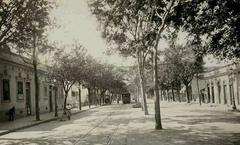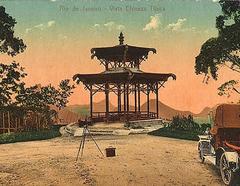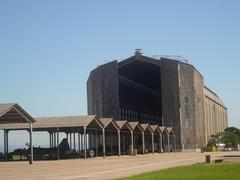Visiting Hours, Tickets, and Historical Significance of Igreja de Nossa Senhora da Misericórdia e Santa Isabel in Rio de Janeiro
Date: 01/08/2024
Introduction
Nestled in the heart of Rio de Janeiro, the Igreja de Nossa Senhora da Misericórdia e Santa Isabel stands as a testament to the city’s rich history and architectural grandeur. This colonial-era church offers a unique glimpse into the past, making it a must-visit for history enthusiasts and cultural explorers alike. Built on the historically significant Ladeira da Misericórdia, the first public road in Rio de Janeiro, the church is a beacon of the city’s early colonial architecture and religious heritage (Wikipedia). The church’s connection with the Jesuit priests and the early settlers of Rio de Janeiro underscores its importance in the educational and religious fabric of the time. Featuring a beautiful facade adorned with Baroque and Portuguese Renaissance elements, and an interior rich with artistic treasures, the church is a visual and cultural delight. This guide will delve into the historical, architectural, and cultural significance of this iconic landmark, provide practical visitor information, and offer tips for enhancing your visit.
Table of Contents
- [Significance of Igreja de Nossa Senhora da Misericórdia e Santa Isabel](#significance-of-igreja-de-nossa-senhora-da-misericórdia-e-santa-isabelsignificance-of-igreja-de-nossa-senhora-da-misericórdia-e-santa-isabel)
- [Historical Significance](#historical-significancehistorical-significance)
- [Architectural Significance](#architectural-significancearchitectural-significance)
- [Cultural and Religious Significance](#cultural-and-religious-significancecultural-and-religious-significance)
- [Preservation and Conservation Efforts](#preservation-and-conservation-effortspreservation-and-conservation-efforts)
- [Visitor Experience](#visitor-experiencevisitor-experience)
- [Practical Information for Visitors](#practical-information-for-visitorspractical-information-for-visitors)
- [Enhancing Your Visit](#enhancing-your-visitenhancing-your-visit)
Significance of Igreja de Nossa Senhora da Misericórdia e Santa Isabel
Historical Significance
The Igreja de Nossa Senhora da Misericórdia e Santa Isabel, located in Rio de Janeiro, Brazil, holds a significant place in the city’s historical and cultural landscape. This church is situated on the Ladeira da Misericórdia, the first public road in Rio de Janeiro, opened in 1567 during the transfer of the city to Morro do Castelo by Estácio de Sá (Wikipedia). The church itself is a testament to the early colonial architecture and religious practices that shaped the city’s development.
The church’s historical importance is further underscored by its association with the Jesuit priests who established the Colégio dos Padres Jesuítas on the Largo do Castelo. This institution played a crucial role in the educational and religious life of the early settlers. Despite the demolition of Morro do Castelo in 1922, the church remains a vital link to Rio de Janeiro’s colonial past, preserving its original cobblestone pavement known as ‘pé de moleque’ (Wikipedia).
Architectural Significance
Architecturally, the Igreja de Nossa Senhora da Misericórdia e Santa Isabel is a fine example of colonial Brazilian church design. The church’s facade is characterized by its simplicity and elegance, reflecting the Baroque style with Portuguese Renaissance influences. The frontispiece is adorned with two volutes and a royal coat of arms in relief, while the windows feature lintels with floral motifs, adding to the church’s aesthetic appeal (Wikipedia).
The church’s interior is equally impressive, with a sacristy that houses a two-colored marble washbasin of Portuguese origin and several intricately carved jacaranda wood pieces. These elements highlight the craftsmanship and artistic sensibilities of the period. Despite facing conservation challenges, the church’s rich decorative features, including paintings and carvings, continue to attract art and history enthusiasts (Wikipedia).
Cultural and Religious Significance
The Igreja de Nossa Senhora da Misericórdia e Santa Isabel is not just an architectural marvel but also a cultural and religious landmark. It has been a place of worship and community gathering for centuries, playing a pivotal role in the spiritual life of Rio de Janeiro’s residents. The church’s dedication to Our Lady of Mercy and Saint Isabel reflects the deep-rooted Marian devotion in Brazilian Catholicism.
The church’s cultural significance is also evident in its role in various religious festivals and ceremonies. These events draw large crowds and are integral to the community’s cultural identity. The church’s association with the Irmandade da Santa Casa de Misericórdia, a charitable brotherhood, underscores its commitment to social welfare and community service. This brotherhood was responsible for establishing the first hospital in Brazil, further cementing the church’s role in the country’s social and religious history (Wikipedia).
Preservation and Conservation Efforts
Preserving the Igreja de Nossa Senhora da Misericórdia e Santa Isabel is crucial for maintaining Rio de Janeiro’s historical and cultural heritage. Over the years, various conservation efforts have been undertaken to restore and maintain the church’s structural and artistic integrity. These efforts are essential to protect the church from the ravages of time and environmental factors.
Despite these efforts, the church has faced challenges in maintaining its condition. Many of its paintings and carvings have suffered from neglect and require ongoing restoration work. The involvement of local and international heritage organizations is vital to ensure that this historical monument is preserved for future generations to appreciate and learn from (Wikipedia).
Visitor Experience
Practical Information for Visitors
When planning a visit to the Igreja de Nossa Senhora da Misericórdia e Santa Isabel, it is essential to consider the following practical information:
- Location: The church is located on the Ladeira da Misericórdia, near the Igreja de Nossa Senhora do Bonsucesso.
- Opening Hours: It is advisable to check the church’s opening hours in advance, as they may vary depending on religious services and special events.
- Admission: While entry to the church is generally free, donations are encouraged to support ongoing conservation efforts.
- Accessibility: The church’s location on a steep incline may pose challenges for visitors with mobility issues. It is recommended to wear comfortable footwear and be prepared for a bit of a climb.
- Photography: Visitors are usually allowed to take photographs inside the church, but it is always best to check for any restrictions, especially during religious services.
Enhancing Your Visit
For visitors, the Igreja de Nossa Senhora da Misericórdia e Santa Isabel offers a unique glimpse into Rio de Janeiro’s colonial past. The church’s historical and architectural features provide a rich context for understanding the city’s development and cultural evolution. Visitors can explore the church’s intricate carvings, historical artifacts, and beautifully preserved interior, gaining insights into the religious and social life of early Rio de Janeiro.
To enhance the visitor experience, it is advisable to visit the church during religious festivals or special events, which offer a vibrant display of local traditions and community spirit. Additionally, guided tours can provide in-depth information about the church’s history, architecture, and cultural significance, making the visit more informative and engaging.
Visitor Guide to Igreja de Nossa Senhora da Misericórdia e Santa Isabel: Hours, Tickets, and Tips
Location and Accessibility
Igreja de Nossa Senhora da Misericórdia e Santa Isabel is situated in the vibrant city of Rio de Janeiro, Brazil. The church is located in a central area, making it easily accessible by various modes of transportation. Visitors can reach the church via public buses, taxis, or ride-sharing services. For those who prefer to drive, there are parking facilities nearby, although availability may vary depending on the time of day and local events.
Best Time to Visit
The church is open to visitors throughout the year. However, the best time to visit is during the cooler months from May to September when the weather is more pleasant for sightseeing. During these months, temperatures range from 18°C to 25°C (64°F to 77°F), making it comfortable for walking tours and outdoor activities. It is advisable to avoid visiting during the peak summer months of December to February, as temperatures can soar above 30°C (86°F), and the humidity can be quite high.
Opening Hours and Tickets
The church typically opens its doors to visitors from 9:00 AM to 5:00 PM, Monday through Saturday. On Sundays, the church may have different hours due to religious services. It is recommended to check the church’s official website or contact them directly for the most up-to-date information on opening hours and any special events that may affect visitor access. While there is no entrance fee to visit the church, donations are appreciated to help with the maintenance and preservation of the historic site.
Guided Tours
For a more enriching experience, consider joining a guided tour. Many local tour operators offer guided tours that include a visit to Igreja de Nossa Senhora da Misericórdia e Santa Isabel as part of a broader itinerary exploring Rio de Janeiro’s historical and cultural landmarks. These tours often provide valuable insights into the church’s history, architecture, and significance. Some tours may also include visits to nearby attractions such as the Candelária Church and the Museu da Misericórdia do Porto.
Dress Code
As a place of worship, visitors are expected to dress modestly when visiting the church. It is advisable to wear clothing that covers the shoulders and knees. Avoid wearing shorts, tank tops, or revealing outfits. Comfortable walking shoes are recommended, especially if you plan to explore other nearby attractions on foot.
Photography
Photography is generally allowed inside the church, but it is important to be respectful of the space and other visitors. Flash photography may be prohibited to preserve the delicate artworks and interiors. Always check for any signage indicating photography restrictions and follow the guidelines provided by the church staff.
Donations and Souvenirs
While there is no entrance fee to visit the church, donations are appreciated to help with the maintenance and preservation of the historic site. There may be donation boxes placed at various points within the church. Additionally, the church may have a small gift shop where visitors can purchase religious items, souvenirs, and literature related to the church’s history and significance.
Nearby Attractions
Igreja de Nossa Senhora da Misericórdia e Santa Isabel is located in an area rich with historical and cultural attractions. After visiting the church, consider exploring the following nearby sites:
- Candelária Church: Known for its stunning Baroque and Neoclassical architecture, the Candelária Church is a must-visit landmark in Rio de Janeiro.
- Museu da Misericórdia do Porto: This museum showcases an impressive collection of religious art and artifacts, providing a deeper understanding of the region’s cultural heritage. More information can be found here.
- Igreja de São Francisco de Paula: Another beautiful church nearby, known for its intricate interior and historical significance. Details about this church can be found here.
Safety Tips
Rio de Janeiro is a bustling city, and like any major urban area, it is important to stay vigilant and take basic safety precautions:
- Stay in well-populated areas: Stick to well-lit and busy streets, especially if you are exploring the city on foot.
- Keep valuables secure: Use a money belt or a secure bag to keep your valuables safe. Avoid displaying expensive items such as jewelry or electronics.
- Be aware of your surroundings: Pay attention to your surroundings and avoid distractions such as using your phone while walking.
- Use reputable transportation: Opt for licensed taxis or ride-sharing services, and avoid accepting rides from strangers.
Language and Communication
Portuguese is the official language of Brazil, and while many locals in tourist areas may speak some English, it is helpful to learn a few basic phrases in Portuguese. This can enhance your experience and make it easier to communicate with locals. Here are a few useful phrases:
- Olá (Hello)
- Por favor (Please)
- Obrigado/Obrigada (Thank you - male/female)
- Quanto custa? (How much does it cost?)
- Onde fica…? (Where is…?)
Cultural Etiquette
When visiting the church and interacting with locals, it is important to be respectful of cultural norms and practices:
- Respect religious practices: If you visit during a service or religious ceremony, be respectful and avoid making noise or taking photographs.
- Greet with a smile: A friendly smile and a polite greeting go a long way in making a positive impression.
- Be patient: Brazilians are known for their relaxed and laid-back attitude. Be patient and flexible, especially when dealing with time schedules and services.
FAQ
What are the visiting hours for Igreja de Nossa Senhora da Misericórdia e Santa Isabel?
The church is typically open from 9:00 AM to 5:00 PM, Monday through Saturday. On Sundays, the hours may vary due to religious services. It’s best to check the official website for the most current information.
Is there an entrance fee to visit the church?
No, there is no entrance fee, but donations are appreciated to help with the church’s maintenance.
Can I take photographs inside the church?
Yes, photography is generally allowed, but flash photography may be prohibited to protect the artworks. Always check for posted guidelines.
Are there guided tours available?
Yes, many local tour operators offer guided tours that include the church as part of a broader sightseeing itinerary.
Conclusion
The Igreja de Nossa Senhora da Misericórdia e Santa Isabel stands as a beacon of Rio de Janeiro’s rich historical and cultural tapestry. Its architectural beauty, historical significance, and cultural relevance make it a must-visit landmark. By planning your visit thoughtfully and supporting conservation efforts, you can help preserve this historical gem for future generations. Whether you’re a history buff, an architecture aficionado, or a curious traveler, this church offers a rewarding and enriching experience. From its intricate carvings and historical artifacts to its role in local religious festivals, the church provides a profound insight into Rio de Janeiro’s colonial past and cultural evolution. Make sure to visit during special events or take a guided tour to fully appreciate the depth of history and artistry that this remarkable church encapsulates.
References
- Wikipedia. (n.d.). Ladeira da Misericórdia (Rio de Janeiro). Retrieved from Wikipedia
- Wikipedia. (n.d.). Igreja de Nossa Senhora da Misericórdia (Olinda). Retrieved from Wikipedia
- Lonely Planet. (n.d.). Museu da Misericórdia do Porto. Retrieved from Lonely Planet
- Wanderlog. (n.d.). Best Churches in Rio de Janeiro. Retrieved from Wanderlog
- Wikipedia. (n.d.). Candelária Church. Retrieved from Wikipedia
